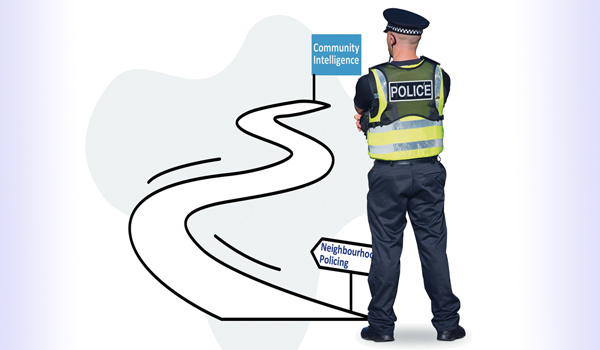A New Year’s ambition
Steve Dodd explains how the new Neighbourhood Policing Pathway can help officers reconnect with their communities and gather vital intelligence.
This year will deliver community policing a positive boost through the introduction of the new Neighbourhood Policing Pathway; a centralised programme delivered nationwide ensuring uniformity in the critical area of community safety.
My ambition is good governance will offer independence of provision through the application of community intelligence-led policing methodology (CILPM) established within the framework.
The first 25 years of the 21st century have passed, moving into its second quarter the challenges facing policing remain forebodingly stark. Community policing is the vanguard, confronting issues head-on, addressing concerns, overcoming obstacles, providing solutions and restoring faith.
There is an inevitability of descending into repeated scrutiny of negative aspects of service delivery compared and contrasted against exaggerated platitudes of faint praise and the hubris laden announcements of progress.
A principal function of government is to keep its citizens safe, with 2024 being a general election year it brought forthright discussions into the public domain not seen since Tony Blair’s ‘tough on crime, tough on the causes of crime’ at the end of the last millennium. While government presents funding, ideology and hope; policing demands financial redress, fairness and independence.
Revisionism, a welcomed philosophy to take us into the new calendar year is a policy of antagonism imposed on pragmatic change by superfluous, gratuitous, nebulous rhetoric.
Trust in policing is quoted as weakening more and more, all the while we discuss the erosion of civic decency. Probity and responsibility have diminished as evidenced by the prevalence of shoplifting, domestic abuse, organised crime and an increased acceptance of morally reprehensible behaviour. It is further evidenced by the expansion of private policing contractors, not only employed at sporting venues, schools, hospitals and shopping malls, but also patrolling residential streets across England.
Aspiration for the implementation of a single community intelligence protocol across the country is the enduring aim. CILPM is a two-way practice; it is the imaginative combination of evidence-based policing with a traditional intelligence-led application under an original construct of the octahedron pyramid.
A structured protocol laminated horizontally and implemented using the transtheoretical approach of a behavioural change methodology.
The police service of 2025 has a multi-functional, effective, adaptable and autonomous workforce: degree entry, post-probationary period qualified, fully conversant with policy and procedure, independent patrol certified, personal safety trained, authorised professional practice skilled, almost limitless continual education provision: immersive learning, licensed product access through ready-to-deliver training programmes and eLearning packages, all comprehensively catering to the requirements of a constable’s knowledge, training and skills as never before.
A cohort of officers further trained and qualified under the Neighbourhood Policing Pathway programme will offer chief constables additional strategic and tactical options – implementation of community intelligence-led policing methodology offering versatility of deployment and a depth to resource management.
The Neighbourhood Policing Pathway will provide officers with a professional qualification comparable with PIP (Professionalising Investigative Programme) and the Intelligence Professionalisation Programme (IPP). This is a welcomed development delivering standardised training across the country, not only benefiting community safety and officer career pathways, but also aiding management’s conviction in its product.
Urban/rural, inner city/town centre, village square/community hub, – neighbourhood officers policing these distinctly different environments are going to possess the same College of Policing issued qualification. This has obvious benefits in terms of uniformity of training and countering differentiations in transferable skills. What community intelligence policing provides is the characteristic. Each of these differentiations is further aligned by constabulary, constituency, mayoral administration, even devolved government, although we have yet to consider on grounds of race, ethnicity, religion, heritage, political persuasion, family or organised crime group affiliation.
Police forces require unilateral authority to manage their resource deployments across the 650 constituency boundaries that make up England and Wales (acknowledging the Police Service of Northern Ireland). People are the same everywhere, human nature is human nature; this is not an excuse for behaviour, more so an acknowledgement of scale. Anti-social behaviour on a village green is as un-nerving and upsetting to residents as it is on an inner-city tower block estate. Problems may be amplified, but, drug abuse, violence towards women and girls, gang culture, knife crime, shoplifting, vehicular misuse, alcohol inebriation, and street fighting, are offensive irrespective of location or magnitude.
There is an overlooked aspect, or perhaps more generously, an undervalued and ill-considered issue, that of rural crime. Apart from a few metropolitan forces the vast majority of constabularies have areas fitting the description. Matrices produced can be interpreted along the lines of the oft-attributed quotation “lies, damn lies and statistics”. However, ultimately producing an accurate picture merely represents less victims but does not quantify the individual suffering experienced. Not only this, but policing must also replace the information deficit lost through the closure of an estimated 650 stations over the past two dozen years with an effective information collection system. A framework for community intelligence to inform within the myriad of initiatives created to engage the public; a methodology designed specifically to supplement operational workflows and provide intelligence analysis with the base data required to effectively function at local levels.
Let us be cognisant of the importance of community intelligence for it is not a contradiction in terms; it feeds into a force’s database, it is subject to National Intelligence Model (NDM) scrutiny, it is compliant with processing standards through the National Decision-Making Model (NDM), the Intelligence Triage Model (ITM), national standards, evidenced based policing (EBP) and codes of practice.
Community intelligence held on a force’s system post-process can irrespective of any ‘interoperability’ arrangements in place be released into the Police National Database (PND), where all legally permitted agencies access the data. Consequently, and far more importantly, a terrorist, shoplifter, car thief, drug mule, people smuggling organised crime group (OCG) member or anti-social thug may at some point be subject to a community intelligence entry on their record.
CILPM has the adaptability of a structured framework and a flexibility of application. Across both rural and urban environments, it provides neighbourhood officers with the ability to contribute at an involved level ensuring ownership.
Neighbourhoods are easily explained as geographic areas, within cities and towns this is probably straightforward, however, rurally this may appear confused. CILPM can consolidate neighbourhoods across force boundaries, even national borders as with North Wales, Cheshire and Merseyside. It can cover vast areas if required, as with the Dyfed-Powys force or South West England or the Yorkshire forces, the North of England’s quadruplets, etc; it is without restriction other than human invention.
In practical policing terms it means ‘local’ is not a geographical restraint: the National Rural Crime Network’s England and Wales figures for 2022 are stark; theft of agricultural vehicles and machinery up 29 per cent to £11,700,000; NFU Mutual’s estimation of the cost of rural crime in 2023 was £52,800,000; and Dyfed-Powys Police chief is quoted on the BBC as admitting 60 quadbikes rurally stolen in 2024.
Community intelligence-led policing will provide open channels of dialogue between intelligence departments through data records supplementing chronicled incidents, crime complaints, criminal prosecutions and intelligence reports. It is a process for neighbourhood policing pathway officers to contribute far more forensically; enabling dialogue, observation, opinion, community supplied information to be collated, analysed and shared.
This is 21st century neighbourhood policing delivering what its rural citizens require, local, mutual cooperation across the divide of the Chiltern Hills, North Yorkshire Moors, the Yorkshire Dales, South Downs, Pennines, Lake District, The Broads; circumnavigating England and Wales’s rural landscapes.
OCGs move from one target to another dependent on product. CILPM mirrors that philosophy – link the targets, prevent victims, identify the perpetrators.
Here is the second delineation: community. Whereas neighbourhood is ostensibly understood as a geographical characteristic, community is more prosaic, it is further protecting citizens not only by location but according to gender, religion, politics, age, sexual orientation, ethnicity, nationality, in fact any categorisation presented. The application of community policing is more generally utilised in urban environments, however neither are exclusive, but for the purpose of this paper it is a useful demarcation.
Here again; the new Neighbourhood Policing Pathway-qualified officers can maximise information collection and intelligence sharing specific to groups (community intelligence) or location (neighbourhood groups).
Encouraging proactive patrols, conversations, observations, instilling commitment and reward; promoting teamwork, ethics, ownership, responsibility and duty. This is what will influence residents and communities at large, promoting confidence in their local ‘bobby’ through improved communication and consultation, a shared bond of belonging, ultimately rebuilding trust in ‘their’ police.
CILPM will absorb the officers, justifying their existence, transforming them into resourceful, proactive, advocates of evidenced-based policing. Problem solving becomes: ‘before, during and after’; what is supplementary? What relevance has the irrelevant? What more can I offer?
Intelligence departments will differentiate the information sources: artificial intelligence, immersive technologies, facial recognition, advanced robotics and ANPR, will all contribute data; officers will observe and engage; analysts will interpret, data analytics will drive informed decision making with management providing governance and direction.
Community intelligence-led policing will take the fight to lawlessness, the urban and rural criminal alike, the violent, the anti-social and the indefensible. Proactively policing communities, establishing identifiable officers for citizens to relate to across villages, towns, inner-city neighbourhoods and rural hamlets. Recording and reporting the insignificant, approaching the indistinguishable, engaging the unknown, questioning the incomprehensible, noticing the imperceptible, inculcating intelligence into the heart of neighbourhood policing.
Steve Dodd is a retired South Wales Police detective. He is a subject matter expert on police intelligence having authored the force’s Community Intelligence Force Policy. An adviser on the College of Policing’s Intelligence Professionalisation Programme, he was deployed on the Government’s working group on the Western Balkans Serious Organised Crime strategy. An international liaison officer, he is an international airline certified extradition officer, plus National Financial Investigator qualified. He is currently writing his ‘Community Intelligence-Led Policing Methodology’ including the octahedron pyramid, a transtheoretical approach, and an inverted strategy thesis.




